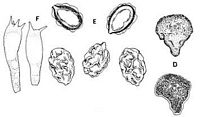|
 Hymenogaster viscidus Hymenogaster viscidus
BiostatusPresent in region - Indigenous. Non endemic
Images (click to enlarge)
Caption: Hymenogaster viscidus: D habit and section (Beaton 42) x 1,
E spores x 1750; F basidia x 1000. |
Article: Beaton, G.W.; Pegler, D.N.; Young, T.W.K. (1985). Gasteroid Basidiomycota of Victoria State, Australia. 3. Cortinariales. Kew Bulletin 40(1): 167–204.
Description: Gasterocarp 0.5-3 cm diam., exceptionally
4-5 cm high, globose, broadly ellipsoid or pyriform, sometimes tapering below
and elongate, with basal attachment but lacking a stipe. Peridium thick, orange
to reddish golden (M.6YR/5.8/8.3) when fresh, drying chestnut brown, smooth
and viscid eventually wrinkled with a silky sheen. Gleba at first white, progressively
becoming dark brown, loculate, consisting of empty chambers, up to 2 mm diam.,
angular or elongate, radially arranged. Tramal plates up to 500 µm thick, hyaline,
consisting of a broad hymenophoral trama and very strongly developed sub-hymenial
layers; clamp-connexions present but small and inconspicuous. Sterile base present,
small, white; columella absent.
Spores statismosporic and symmetric, 11.5-14.5
x 7.5-9(13.5 ± 0.5 x 8.5 ± 0.3) µm (inc. myxosp.), Q = 1.58; obovoid to ellipsoid,
golden brown, with a thickened wall with finely verruculose exosporial ornamentation,
enclosed in a hyaline, membranous myxosporium which often appears reticulately
wrinkled. Basidia 30-40 x 9-10 µm, clavate, bearing either two or four, narrow,
straight sterigmata. Hymenophoral trama regular, hyaline, of parallel, thin-walled,
inflated hyphae, 3-13 µm diam. Subhymenial layer strongly developed, 40-55 µm
thick, a strongly developed ixodermium, overlaying a differentiated hypodermium,
ixodermium of erect and semi-erect, narrow, non-inflated, hyaline hyphae, 2-4
µm diam., embedded in a hyaline, gelatinous matrix. Hypodermium of inflated,
thin-walled hyphae, 3-30 µm diam., with an orange membrane pigment, forming
agglutinated clusters at 40-80 µm intervals.
Notes: Massee (1891:97) proposed the genus Protoglossum,
with P. luteum as the type and only species, from Victoria State, for
a subepigeal fungus with a tapering subterranean base and an apex emergent at
soil level. Cunningham (1944: 50) examined the type collection and found it
to represent the same species that Massee & Rodway had earlier described
under the name Hysterangium viscidum. Hymenogaster viscidus is
easily recognized by several unique structures, including the complexity of
the gelatinized peridiopellis, and the wrinkled myxosporium on the spores. It
was illustrated by Cooke (1892: pi. 18/134) and by Rodway (1911: pi. 3/8).
|